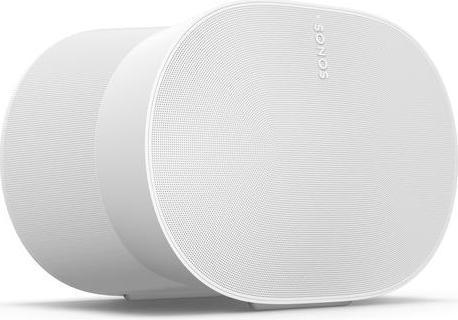
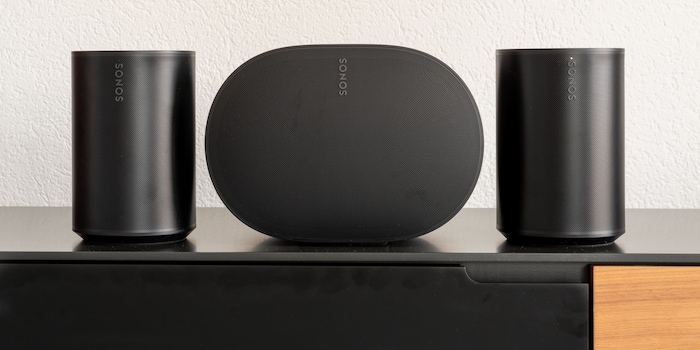
Sonos Era review: one isn’t enough
One speaker alone can’t produce full stereo sound. No marketing promise Sonos makes can change that. But the new Era 100 and Era 300 sound really good – provided you get at least two.
The Sonos Era 100 and Era 300 speakers were launched simultaneously and they have a lot in common. For example, their connectivity options, operation and stereo capability. I went ahead and tested them both out together, though my focus lies on the Era 100; I received two of them for testing, and they’re more suited to my home.
The Era 100 is a small speaker and the successor to the Sonos One. The Era 300 is larger, though still slightly smaller than the Sonos Five, and is geared more towards omnidirectional sound and the home theatre. It’s an entirely new speaker in Sonos’ line-up. For details on the two models, check out the article linked below.
Connectivity: versatile
Both devices have done away with the Ethernet port. Instead, there’s now a USB-C port to which you can connect a 3.5 mm audio cable via an adapter. This means that you can also use retro sources like a CD player with the speakers. Just be careful with record players. They either have to have a preamp built in or you’ll have to connect one. Although you can adjust the input level in the Sonos app, an unamplified turntable signal is too weak – and not equalised. A phono preamp takes care of both in one go.
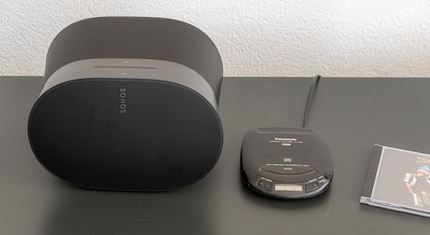
Source: David Lee
The line-in is simple to use. If I play a CD, the connected Sonos system switches on automatically. I can also have it turn on other speakers, even ones that aren’t in the same group. In addition, I can adjust the delay. For music, I select the highest possible delay, as this makes the transmission more stable. For the TV or another video source, a lower delay is recommended so that the picture and sound match.
You have to buy the line-in adapter separately. Like the speakers, it comes in black and white. I like that it’s small and inconspicuous. Visually, there’s not much difference to a direct connection.
The Era speakers can also be operated with Bluetooth instead of Wi-Fi, so guests can pair their phones and play music, for example. The Sonos speakers remain connected to the Wi-Fi network, making multi-room and stereo operation possible even via Bluetooth. With Wi-Fi switched off, only a single speaker can be controlled via Bluetooth.
Hassle-free operation
The controls on the Era 100 and 300 are identical. On the top is a touch control panel with a volume slider. You can either swipe to adjust the volume or simply place your finger on the plus or minus symbol. You can also play/pause, switch to the previous and next track and activate your voice assistant. I didn’t test the latter, as I don’t normally use it.
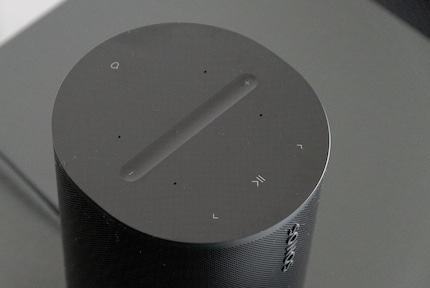
Source: David Lee
On the back, you’ll find the Bluetooth button (at the top) and a slider for turning the microphones on and off (at the bottom). The microphones are not only used for voice control, but also for automatically optimising sound. Sonos speakers can be adapted to the given room. After an initial calibration, the system uses the integrated microphones to continuously improve sound, so it’s a good idea to leave them on. Mind you, it´s hard to say just how much of a difference it makes, as the change is gradual. After resetting the speaker, I did think the sound became less pleasant.
One single Era 100: what stereo sound?
Both Era speaker models can produce stereo sound on their own. The Era 100 is the successor to the Sonos One. Since the Sonos One can only do mono on its own, Sonos touts this as a pro of the Era 100.
The Era 100 has two angled tweeters. However, the stereo effect this creates is very modest and by no means a substitute for two speakers. If you want surround sound in your living room, I definitely recommend buying more than one speaker. The difference is immense. And the Era 100’s side-firing tweeters are a boon even with two speakers; thanks to their omnidirectional sound, you won’t have to sit right in the sweet spot.

Source: David Lee
One single Era 300: good, but two are better
The Era 300 is even more geared towards creating as much surround sound as possible on its own. Its speakers radiate in all directions – one upwards as well. The latter isn’t of much use when listening to music, but is an advantage in a home theatre set-up with Dolby Atmos. However, I wasn’t able to test it for lack of a home theatre.
The stereo effect of the Era 300 really is greater than that of the Era 100. But, again, it’s not enough to replace a pair of speakers. It makes a big difference if you’re getting bidirectional sound from a single point or from two different sources and points. Granted, music is reflected off the walls, which can create the slight illusion that there are several speakers in the room. But not all frequencies reflect off the walls to the same extent, and a room with good acoustics shouldn’t reflect too much anyway.
To take full advantage of the Era 300’s omnidirectional radiation, you’ll have to position it so that it’s unobstructed from all sides, including from the top, if possible.
The Era 300 sounds full and does a nice job filling the room. At very low frequencies, it has more juice than the Era 100. That’s no surprise. But what is surprising is that it doesn’t sound more bass-heavy overall that its little brother. On the Era 100, the bass sometimes seems a bit forced, while the Era 300 seems content to understate its power.
Two Era 100 as a stereo pair
You can link two Era 100s to work as a stereo pair – an elegant solution that saves space and is in many cases enough. Sure, they won’t give you the ultimate boom. But the volume and bass are sufficient for a medium-sized living room. The Era 100 is a lot more powerful than a battery-powered mobile Bluetooth speaker of the same size. I’m impressed by its sound.
I can’t draw a direct comparison to the Sonos One, but according to Sonos, the mid-range driver in the Era 100 is 25 per cent larger. It should therefore be capable of producing stronger bass than the Sonos One.
A pair of Era 100s lends itself to listening to classical music, not least because you can hook up conventional sources to it. Until now, this was only possible if you had the much more expensive Sonos Five or a Sonos Port in your set-up.
All three speakers in stereo mode
I also tested all three speakers together in stereo mode. This definitely isn’t a standard use case. The two Era 100s are more likely to be paired with a soundbar in a home theatre set-up, or perhaps with a subwoofer. But I wanted to try it out anyway.
I placed the Era 300 in the centre and the Era 100 a little higher up to the left and right. The Era 100s work together as a stereo pair, while the Era 300 produces stereo sound itself.
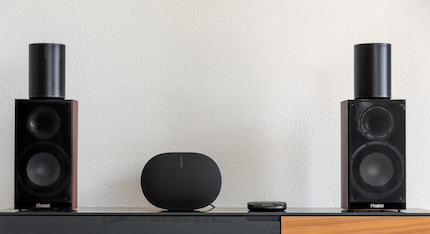
Source: David Lee
It sounds surprisingly good – clear and full! A huge plus in my eyes is the fact that you can adjust the volume of each speaker individually both on the device and in the app. You can also modify the equaliser settings separately in the app. If you set the Era 300 to be bass-heavy and the two Era 100 to be treble-heavy, you can simultaneously adjust the sound alongside the volume. Even though it’s unlikely Sonos intended it, this is a perfectly workable set-up.
Verdict: take two
Sonos has done a good job on the two Era speakers. Line-in and Bluetooth make them versatile, even with multiple speakers.
The Era 100 sounds very good for its size. However, I definitely recommend buying two of them; the stereo effect you get from just one is modest. As a pair, the little guys are quite capable of filling your living room with sound. It’s the classic way to listen to music – and the option to hook up a conventional source is fitting.
The Era 300 also convinces me in terms of sound, though, again, I think you need a pair of them. On its own, the Era 300 doesn’t sound very three-dimensional, even though you can definitely tell sound is being projected in multiple directions. To my surprise, the unorthodox combination of the Era 300 with two Era 100s also sounds really good.
The Era 300’s field of application is more home theatre than hi-fi. As part of a surround system, they should, presumably, be able to make full use of their omnidirectional sound projection. However, as I’ve tested neither, I can’t give any recommendation.
My interest in IT and writing landed me in tech journalism early on (2000). I want to know how we can use technology without being used. Outside of the office, I’m a keen musician who makes up for lacking talent with excessive enthusiasm.
